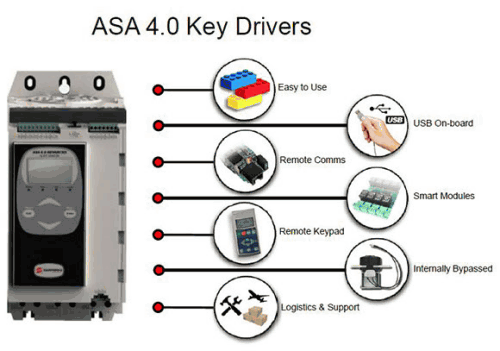What is adaptive acceleration control?
November 2020
Motion Control & Drives
Adaptive acceleration control (AAC) is a new soft start control type that allows the selection of different acceleration and deceleration profiles according to application needs. Soft starters offer a variety of methods for the control of motor starting and stopping. Each type of the control uses a different primary control parameter.
Constant current is the traditional form of soft starting, which raises the current from zero to a specified level and keeps the current stable at that level until the motor has accelerated. Constant current starting is ideal for applications where the start current must be kept below a particular level.
Current ramp soft starting raises the current from a specified starting level to a maximum limit over an extended period of time. Current ramp starting can be useful for applications where the load varies between starts, the load breaks away easily but starting time needs to be extended, or the electricity supply is limited.
Kickstart provides a short boost of extra torque at the beginning of a start, and can be used in conjunction with current ramp or constant current starting. Kickstart can be useful to help start loads that require high breakaway torque but then accelerate easily (for example flywheel loads such as presses).
AAC is a new intelligent motor control technique. In an AAC soft start, the ASAB soft starter adjusts the current in order to start the motor within a specified time and using a selected acceleration profile. It is based on two algorithms, one for measuring (learning) the motor characteristics and one for controlling the motor. During each start it makes two speed estimates, zero speed at LR and maximum speed at the point when the motor is operating at maximum efficiency. During subsequent start and stop operations, measuring the motor characteristics and using this value to determine the speed between the two known end points provides an estimate of motor speed. The control algorithm creates a time based speed profile which can create curves from a mathematical function. During each start and stop operation the control algorithm compares the speed estimate with the speed ramp profile. If the speed estimate is too low it increases the power to the motor and decreases the power when it is too high. This allows for control of the three accelerating and three decelerating profiles, and if the motor does not start and stop smoothly to fine-tune adjust the adaptive control gain.
Further reading:
WEBER-HYDRAULIK modernises warehouse in record time
Motion Control & Drives
WEBER-HYDRAULIK is a leading international specialist in customised hydraulic solutions. After its old buffer warehouse had become outdated and was partially worn out mechanically, the decision was made to completely renovate it.
Read more...
OMC deploys cobots to improve throughput ten times
Motion Control & Drives
OMC, a pioneer in optoelectronics design and manufacture, is investing to introduce innovative cobot technology onto its fibre optic production line.
Read more...
Yaskawa Southern Africa launches laser welding cell
Yaskawa Southern Africa
Motion Control & Drives
Yaskawa Southern Africa has partnered with Industrial Manufacturing Systems South Africa to introduce the Megmeet laser welding cell, a breakthrough solution combining precision robotics with cutting-edge laser technology.
Read more...
Next-gen planetary gearboxes
SEW-EURODRIVE
Motion Control & Drives
Leading the way in planetary gear unit innovation, SEW-EURODRIVE is extending its reach across a growing range of industries, delivering the advantages of this powerful technology through locally engineered solutions that ensure faster lead times.
Read more...
Record-breaking dragline relocation
Motion Control & Drives
Draglines are key pieces of equipment in open-pit mining. BHP Mitsubishi Alliance entrusted Mammoet with the relocation of a 3100 ton Marion 8050 dragline from one end of the Peak Downs coal mine in Queensland, Australia to another, a full 27 km away.
Read more...
igus expands 3D printing capabilities
igus
Motion Control & Drives
Motion plastics specialist, igus South Africa has introduced a new 3D printing service capable of producing custom parts in two engineering-grade polymers with exceptional strength and without the need for lubrication.
Read more...
Bühler adds new die refurbishment machine
Motion Control & Drives
Bühler has reinforced its commitment to customers in southern Africa with the installation of a new die refurbishment machine at its Johannesburg workshop.
Read more...
SEW-EURODRIVE drives innovation at automotive plant
SEW-EURODRIVE
Motion Control & Drives
[Sponsored] A major automotive manufacturer in Gauteng has boosted its operational efficiency, safety and energy savings with the installation of SEW-EURODRIVE’s advanced MOVIGEAR mechatronic drive system in its newly expanded buffering zone.
Read more...
Reimagining rotation for a circular and sustainable future
SKF South Africa
Motion Control & Drives
Through the design and manufacture of components with sustainability at their core, SKF is reimagining the future of rotation, rolling away from traditional, consumable-based thinking toward a smarter, more sustainable circular approach.”
Read more...
Optimising operational efficiencies through advanced filtration systems
Bearing Man Group t/a BMG
Motion Control & Drives
Filtration is the only effective defense against wear and tear when contaminants are present. It is therefore critical that effective filter components are correctly used to ensure dependable performance, high efficiency and extended service life of machinery and vehicles.
Read more...


